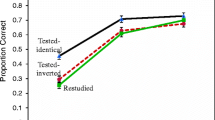Abstract
The proposal is made to consider a paired-associate item as becoming conditioned to its correct response in all-or-none fashion, and that prior to this conditioning event the subject guesses responses at random to an unlearned item. These simple assumptions enable the derivation of an extensive number of predictions about paired-associate learning. The predictions compare very favorably with the results of an experiment discussed below.
Similar content being viewed by others
References
Anderson, T. W. and Goodman, L. A. Statistical inference about Markov chains.Ann. math. Statist., 1957,28, 89–110.
Bruner, J. S., Miller, G. A., and Zimmerman, C. Discriminative skill and discriminative matching in perceptual recognition.J. exp. Psychol., 1955,49, 187–192.
Bower, G. H. Properties of the one-element model as applied to paired-associate learning. Tech. Rep. No. 31, Psychol. Ser., Inst. for Mathematical Studies in the Social Sciences, Stanford Univ., 1960.
Bower, G. H. A model for response and training variables in paired-associate learning.Psychol. Rev., in press.
Bush, R. R. Sequential properties of linear models. In R. R. Bush and W. K. Estes (Eds.),Studies in mathematical learning theory. Stanford: Stanford Univ. Press, 1959. Pp. 215–227.
Bush, R. R. and Mosteller, F. A comparison of eight models. In R. R. Bush and W. K. Estes (Eds.),Studies in mathematical learning theory. Stanford: Stanford Univ. Press, 1959, Pp. 293–307.
Bush, R. R. and Sternberg, S. A single-operator model. In R. R. Bush and W. K. Estes (Eds.),Studies in mathematical learning theory. Stanford: Stanford Univ. Press, 1959. Pp. 204–214.
Estes, W. K. Toward a statistical theory of learning.Psychol. Rev., 1950,57, 94–107.
Estes, W. K. and Burke, C. J. A theory of stimulus variability in learning.Psychol. Rev., 1953,60, 276–286.
Estes, W. K. Component and pattern models with Markovian interpretations. In R. R. Bush and W. K. Estes (Eds.),Studies in mathematical learning theory. Stanford: Stanford Univ. Press, 1959. Pp. 9–52.
Estes, W. K. Learning theory and the new mental chemistry.Psychol. Rev., 1960,67, 207–223.
Miller, G. A. and McGill, W. J. A statistical description of verbal learning.Psychometrika, 1952,17, 369–396.
Murdock, B. B. The immediate retention of unrelated words.J. exp. Psychol., 1960,60, 222–234.
Rundquist, W. N. and Freeman, M. Roles of association value and syllable familiarization in verbal discrimination learning.J. exp. Psychol., 1960,59, 396–401.
Suppes, P. and Atkinson, R. C.Markov learning models for multi-person interactions. Stanford: Stanford Univ. Press, 1960.
Suppes, P. and Chmura, H. A statistical test for comparative goodness of fit of alternative learning models. Tech. Rep. No. 36, Psychol. Ser., Inst. for Mathematical Studies in the Social Sciences, Stanford Univ., 1961.
Author information
Authors and Affiliations
Additional information
This research was supported by a grant, M-3849, from the National Institutes of Mental Health, United States Public Health Service.
Rights and permissions
About this article
Cite this article
Bower, G.H. Application of a model to paired-associate learning. Psychometrika 26, 255–280 (1961). https://doi.org/10.1007/BF02289796
Received:
Revised:
Issue Date:
DOI: https://doi.org/10.1007/BF02289796




